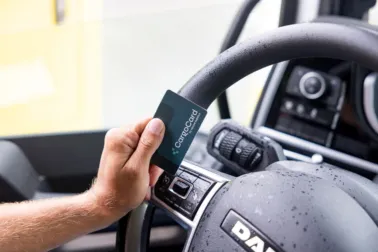No carrier chooses to work with criminal networks, and most have their due diligence properly in place. Yet it is often that one rushed moment where things go wrong.
On a Friday afternoon, a return load is offered at the last minute. The driver can just make it within driving hours, the documents appear in order and the provider looks reliable online. Nothing to worry about, right? Until it turns out the documents were previously stolen through fraud and the criminal digitally disguised themselves as a legitimate carrier. In hindsight, the only difference was a single missing letter in the email address…
The new reality in logistics
Criminals increasingly use legitimate carriers or their subcontractors as unaware intermediaries. They respond to transport assignments with false identities, arrange the trip and then change the delivery address on the way or shortly before arrival. Along the route they empty the trailer, leaving the carrier with the losses.
In some cases, the damage runs into the millions. The assumption that insurance always covers this is incorrect. National and international CMR conditions provide only limited protection, causing carriers to face financial problems and even threatening business continuity.
Reports of fraud by fake carriers now come in daily. The total annual damage in the Benelux is estimated at more than 350 million euros.
What exactly is a fake carrier?
A fake carrier is an organization or individual claiming to provide transport services but in reality is not a carrier at all. Often, they lack licenses, insurance or any real business activity. They present themselves as reliable partners, use falsified documents and request upfront payments or deposits.
The rise of digital marketplaces and the use of artificial intelligence has made this type of fraud easy and lucrative.
How can you protect your business against fake carriers?
Prevention is better than cure. These measures help keep fake carriers out:
- Check the European transport license or the self-employed driver declaration
- Check the Chamber of Commerce registration in the country of establishment
- Verify email addresses and phone numbers and compare these with the official website
- Be alert when deals are rushed or when sudden changes occur. Criminals often push for speed to avoid detection
- Request additional documents if in doubt. Criminals may have a set of forged load documents, but formal documents unrelated to the shipment usually cannot be provided
- Be cautious with free email services like Gmail or Outlook. Always verify these details against the provider’s official website
- Consult your network; together you know more
- Work only with parties that have a valid Secure Logistics EAN
- Use the XS ID or EAN as a secure login method within your own digital environment. This ensures only verified employees or partners can log in with an identity preverified by Secure Logistics
What is the Secure Logistics EAN?
Secure Logistics is the creator and operator of the CargoCard, which facilitates thousands of driver and company verifications every day.
The CargoCard was developed to make access to terminals faster, safer and more convenient, and to reduce paperwork. This was only possible by knowing exactly who someone is, which company they work for and by reliably recording this information. Over the years, more documents have been added and data validation has been refined. To strengthen this process, we continued to expand our customer service expertise and implemented integrations with essential registers, creating a solid foundation for digital identification in the logistics chain.
Automated systems work not in text but in numbers or character strings. To enable verification at company level, Secure Logistics developed the Secure Logistics EAN. This is a unique numeric identifier issued only to organizations that have been fully vetted.
An EAN is issued only when a company meets all requirements: Chamber of Commerce registration, validation of the authorised signatory or owner, VAT verification through VIES, creditworthiness check and, if applicable, a valid transport license.
For employees in the logistics chain, including drivers, a similar process applies. They receive an XS ID: a personal digital identity comparable to a professional version of a national identification number. This identity is linked to the EAN of their employer.
The combination of these two unique numbers makes it possible to know who receives access, on behalf of which company and with which permissions. This combination made it possible to secure the Trust Chain within the container sector and eliminate PIN code fraud.

The power of a controlled Logistics chain
The rise of fake carriers shows that traditional checks are no longer sufficient. A Chamber of Commerce extract or a copy of a driver’s license means little if the identity behind it is not verified. The lesson is that trust in logistics is not automatic. It must be built, validated and digitally safeguarded.
The Secure Logistics EAN and XS ID make this possible. They connect identity, company and authority in one system that provides certainty. This ensures:
- Less risk of fraud and financial loss
- More transparency
And above all: certainty about who you are working with
Fake carriers will continue to exploit speed and digitalisation, but with verified identities, reliable partners and a secure chain, their room to operate diminishes.
